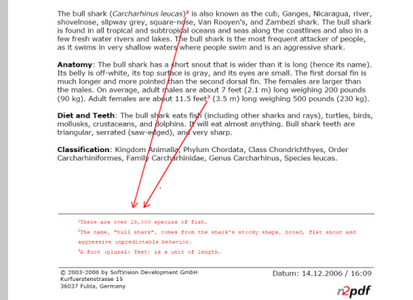The footnotes let you relocate longer comments, or details about the source, from the main text to the end of the page. The footnotes are separated from the main text with a footnote line (underline), and given consecutive numbering. The formatting of the area in which the footnotes are shown can be selected using a text template.

To add a footnote for a single word, a template is defined in the text. This template defines the footnote text, and comes immediately after the word that is to have a footnote. n2pdf automatically converts such a template into a footnote.
Example of a template for a footnote after the word "feet" with the text "(A foot (plural: feet) is a unit of length":

You can add a template for a footnote to the PDF content using the content of a RichText field (see image), as an element of a form, and also using the function N2PDFAddContent.
Example of a template using N2PDFAddAttachment:
FootNote = "Anemonefish [FOOTNOTE:Currently 27 species exist.]"
Call N2PDFAddContent ( JobID, N2PDFVALUE_CONTENT_BODY, 0, Footnote )
Footnotes correspond to the principle of "user-defined links" and can be formatted with a text template with the name N2PDFVALUE_FOOTNOTE_PARAGRAPH_NAME.
If you do not want to use footnotes in the PDF file, you can deactivate them with the option N2PDFOPTION_SPEED_NO_FOOTNOTES (N2PDFSetOption). Set the option to the value N2PDFVALUE_FALSE. The processing speed will then be improved, since the search for footnotes and the formatting adjustment will be deactivated.
Example: Deactivating the footnotes
Call N2PDFSetOption ( JobID, N2PDFOPTION_SPEED_NO_FOOTNOTES, N2PDFVALUE_FALSE, "" )